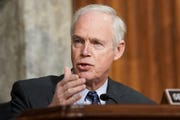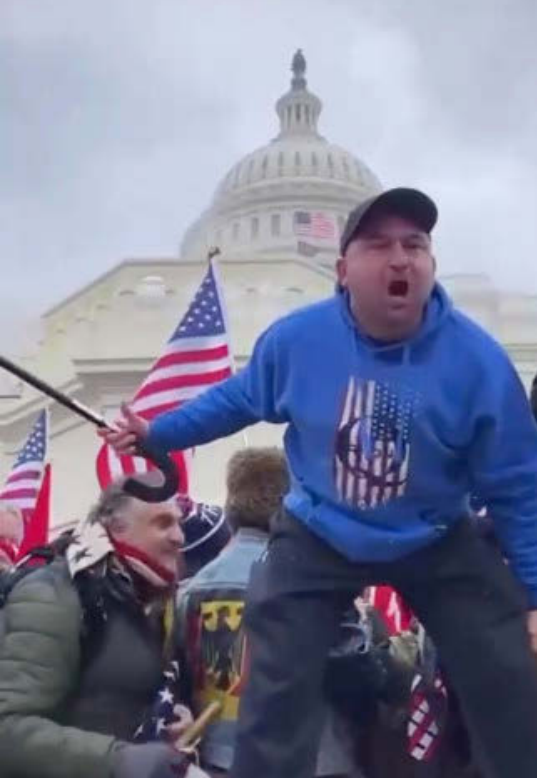Many accused in the Capitol attack placed their campaign cash on Trump, Republicans
Capitol rioters made no secret of their support for Donald Trump.
They donned his signature red caps and wore clothes emblazoned with his name as they disrupted Congress on Jan. 6.
They praised him before the insurrection on social media and afterward in interviews with reporters and the FBI.
And, according to campaign finance records, many of the same people charged in the Capitol riot sent their own money to Trump’s re-election campaign. Even after his loss in November, they threw their cash behind his efforts to challenge the election as he touted the lie that it had been stolen.

President Donald Trump encourages protesters during a rally against the congressional confirmation of Joe Biden as president Jan. 6 in Washington. (Photo: Evan Vucci/Associated Press)
A USA TODAY analysis of Federal Elections Commissions records for 2019 and 2020 reveals that at least 75 of the 307 people charged in connection with the riot through March 18 made political donations. More than 98% of their contributions went to Republican candidates and committees, and nearly 87% of them donated to Trump.
Despite the repeated insistence of some Republicans that antifa agitators attacked the Capitol that day, the contributions add to the already ample evidence that those who took part in the insurrection were there for Trump .
“It’s yet another indicator of exactly who these rioters were – they were clearly rioters who were supportive of Republican voices in Congress and Donald Trump in particular,” Costas Panagopoulos, professor of political science at Northeastern University, said of the donations.
“With each new data point, the narrative that the Capitol rioters were, as a group, anything but mainly Trump and GOP supporters is crumbling.”
Among USA TODAY’s other findings:
► Accused rioters gave at least $39,734, with the vast majority of that – $24,822 – going to Trump. By contrast, donations to Democratic candidates or campaigns accounted for at least $650, or less than 2% of the total. Even that is skewed by one contributor who gave more than $500 to Democratic presidential candidate Andrew Yang.
► Money continued to roll in after the Nov. 3 election, with more than $10,600 – or 25% – of all contributions coming as Trump fundraised off his false claims that he had won the election and needed to fight it in court. At least 40 of the accused rioters made contributions after the election.
► The median contributor gave $150. Eleven people gave more than $1,000.
USA TODAY’s totals are almost certainly an undercount of donors. Federal laws require campaigns to itemize contributions from individuals exceeding $200. While the FEC data on the rioters included some contributions below that amount, others likely went unrecorded.
Collectively, the accused rioters’ donations represent a drop in the bucket of Trump’s reelection effort. According to the Center for Responsive Politics, Trump’s campaign raised more than half of its $774 million from donors giving $200 or less.
Yet the donations make clear the arrestees supported Trump financially before they stormed the Capitol on his behalf.

Sen. Ron Johnson, R-Wis. (Photo: Greg Nash, AP)
Republican politicians and right-wing media have pushed conspiracy theories that antifa – which is short for anti-facsist – led the attack. During a hearing on the riot last month, Sen. Ron Johnson (R-Wisconsin) read an article that falsely claimed provocateurs were responsible for the violence. Johnson argued the vast majority of Trump supporters are pro-law enforcement and wouldn’t violate the law.
Asked Thursday about the campaign contributions accused rioters made, a spokesman for Johnson drew a distinction between the people charged and the thousands of Trump supporters gathered at the Capitol.
”The senator and you are discussing two distinct groups of people,” he said. “Your findings about the one, small group he has condemned have no bearing on the much larger group that peacefully exercised its First Amendment right of protest.”
A Suffolk University/USA TODAY Poll last month found that 58% of Trump supporters characterized the Jan. 6 attack as “mostly an antifa-inspired attack that only involved a few Trump supporters.”
In a Senate hearing earlier this month, FBI director Christopher Wray said antifa are not among those being investigated in the expansive criminal probe that has included hundreds charged in the riot with more cases being filed.
The campaign contributions of the people charged in the insurrection add to the voluminous evidence that Trump supporters led the attack, experts said.
“You think that the kind of person who is motivated enough to get on a plane or otherwise drive a significant distance to come down and march on the Capitol, that’s someone who is extremely engaged. That requires a lot higher level of engagement than clicking three times on your phone (to donate),” said David Barker, director of the Center for Congressional and Presidential Studies at American University.
“That’s somebody who’s a true believer. They were stopping the steal. They were saving the country, as far as they’re concerned. They’re people who care an awful lot, and that’s the people who donate – people who care an awful lot.”
It’s rare to give
Political donations in and of themselves are a rare step of participation among Americans.
Just 1% to 2% make donations large enough to show up in FEC records, said Jake Grumbach, an assistant professor of political science at the University of Washington. Donald Green, a political science professor at Columbia, estimated it at 2% to 3%.
More than 24% of those charged related to the riot made donations, though.
“That’s extremely high,” said Robert Boatright, professor of political science at Clark University. “Most people don’t give any money at all, and those who do give tend not to give all that much.”
Experts noted Trump excelled at raising small contributions during this election cycle and persuaded people to donate who hadn’t before or who had supported Democrats.
Indeed, of the 75 contributors USA TODAY could identify among those charged, only six had contributed during the two-year period that included the 2016 presidential election when Trump first was on the ballot.
Those 2016 results were much the same: More than 99% went to Republican candidates or groups and nearly 55% to Trump.
Such donations indicate partisanship, experts said.
“People don’t generally give to political candidates and causes willy nilly,” Panagopoulos said. “The inferences that one can draw about individuals’ political beliefs from their campaign contributions are generally accurate.
“When someone gives to Republicans or Donald Trump, they’re generally supportive of their views.”
Post-election contributions
After Election Day, experts said, donations normally drop off.
“You would expect to see hardly any. The campaign is over,” Barker said. “That’s the dead zone.”
It wasn’t in 2020.
Even before his loss, Trump had complained that fraud would be rampant and that Democrats would steal the election. After the votes were cast, Trump lost dozens of challenges in state and federal courts that found no merit to his claims.
But he used the rhetoric to raise money, including among people who would go to the Capitol on Jan. 6. Accused rioters gave more than $10,000 collectively after Nov. 3. That included nearly $7,700 to Trump, more than five times as much as Republican Senators David Perdue and Kelly Loeffler received. They faced a Jan. 5 runoff in Georgia that they ultimately lost.
“I wouldn’t have expected that,” Grumbach said. “It seems consistent with the idea that because one of the central things of this coalition was that the election was stolen, so there was this need to fund raise after the election for that.”
Green said post-election donations typically come from stalwart partisans seeking to help candidates retire debt.
To be sure, post-election donations did that. But fundraising appeals from Trump touted his team’s legal efforts to challenge the election results. Only in the fine print did they disclose at least half would go to campaign debt, with a percentage also going to the Republican National Committee.
“We’ve not ever had a situation like this where a defeated presidential candidate immediately went out and started raising money, not for a campaign but for an independent group,” Boatright said. “They got more agitated after the election, which makes sense because Trump got more agitated. He tried very hard to mobilize these folks, so it makes sense that these people who had been involved in supporting Trump in some way before the election got more worked up.”
Forty of the accused rioters continued to donate after the election, and 14 of those only donated after Trump’s loss.
One stood out.
James Uptmore was charged with entering the Capitol along with his son, Chance, whom he had taken to Washington on a birthday trip. According to their arrest affidavit, James Uptmore told his son not to enter the building before following Chance in once he did.
James Uptmore donated at least $1,140 after the election, almost entirely to committees supporting Trump. He also donated to Trump in 2016. Uptmore did not return messages from USA TODAY and does not have an attorney listed in his court case.
“There were clearly a sizable proportion of these donors who were motivated by Trump’s loss to contribute and the perceptions around what happened in the election,” said Panagopoulos. “Clearly that’s what fueled their motivation to give, and it could have been driving not only their contributions but also their decision to participate in the riot.”
Individual contributors
Political scientists described the typical donor as older and affluent. Grumbach’s research shows 91% of money to state and federal candidates from 1980 to 2012 came from non-Hispanic white contributors.
Green said political fundraisers tell campaigns that the typical donor is over 65, an ardent partisan who has donated in the past. Often they live in affluent areas.
The contributors among those charged in the riot defy that. They range in age from 20 to 67, with a median age of 43. While it’s difficult to judge their financial means, their listed occupations offer some clues.
Among the list are a bartender and a beautician, a CEO and CPA, a realtor and a sanitation worker.
“What’s odd about that is you don’t think of the suspected rioters as being highly affluent people. Some are, but what’s interesting is they’re not particularly old and not particularly affluent, so they don’t fit the profile of a Trump donor but they are,” Green said.
“It suggests that the median person on your list of 70 something is a person who is fired up. They’re giving relatively small amounts and maybe that’s all they can afford.”
Several of those charged gave small donations to Trump and other Republican candidates or committees that built over time.

Dominick Madden (Photo: U.S. Department of Justice)
Dominick Madden, a sanitation worker from New York, gave more than $4,200 over the two-year period, with nearly $2,900 going to committees supporting Trump. The bulk of the remaining amount went to other Republican committees. Madden faces four charges related to entering the Capitol, and his arrest affidavit says surveillance video put him in the building for about 13 minutes.

Robert Ballesteros (Photo: U.S. Department of Justice)
Robert Ballesteros, a contractor from New York, gave more than $4,200 over the two year period, with $1,245 going to Trump. He divided nearly $1,200 between the National Republican Senate Committee, National Republican Congressional Committee and Republican National Committee. The rest was split between 85 other Congressional candidates. He faces one charge related to entering the Capitol after posting a video of him in the building on Instagram, according to court records.
Brad Rukstales (Photo: Cogensia LLC)
Former Cogensia CEO Bradley Rukstales, who was among 14 people arrested that day at the Capitol, was the single biggest contributor. He donated more than $9,800 to Republican candidates and groups over the two years, with $6,300 going to committees supporting Trump. Rukstales faces four charges related to entering the Capitol after he and five others ignored police orders to leave.
None of those men responded to messages from USA TODAY, either directly to them or through an attorney.
Brian McCreary accounted for the bulk of the donations to Democratic candidates, with at least $500 he contributed to Andrew Yang’s presidential campaign.
McCreary said he supported Yang’s platform during the presidential primary, specifically noting Yang’s support for universal basic income, a text line to report robo-calls and decriminalizing small amounts of opioids, as Portugal has done.
McCreary said he was at the Capitol on Jan. 6 to support an audit into voting irregularities, no matter how few there were.
“I wasn’t there specifically to support Donald Trump,” said McCreary, who was registered as a Democrat and now says he feels more independent. “In my opinion, any amount of fraudulent activity should warrant an audit.”
McCreary said he didn’t know what to expect at the Capitol and that he followed others to record once he saw them destroying property. He made the same statement in an FBI interview and his arrest affidavit shows he submitted several video clips to the agency through an online portal.
McCreary said he was not surprised most of the campaign contributions from others charged for the riot went to the former president and Republicans.
“That’s something to be expected,” McCreary said. “It was his event.”
Source: Read Full Article

